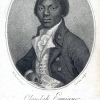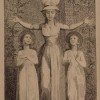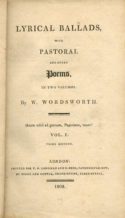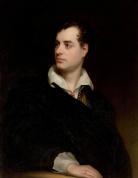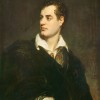Explorations Timeline
Created by Sophie Thomas on Mon, 11/29/2021 - 15:30
Part of Group:
Here you'll find (and can add!) useful information relevant to our period.
Timeline
Chronological table
| Date | Event | Created by | Associated Places | |
|---|---|---|---|---|
| 28 Jun 1712 to 2 Jul 1778 |
Jean-Jacques RousseauJean-Jacques Rousseau, born in Geneva, Switzerland, is named "The Father of Romanticism" because of his work in the Enlightenment period, where he wrote a very detailed and uncencored autobiography, titled Confessions. Rousseau's thinking was so forward, it did not conform to societal rules of the Elightenment period, paving the way for other creative minds to share their work in the upcoming era. This provided writers such as Mary Shelley, Edgar Allen Poe, and John Keats with a window of opportunity to show their creativity in their "abnormal" works. The individuality of their pieces brought forth the freedom, love of nature, and expressionism of the Romantic period. |
Evangelia Kaplanis | ||
| Jan 1789 |
Interesting Narrative of the Life of Olaudah Equiano
Articles |
David Rettenmaier | ||
| circa. Spring 1789 to circa. Autumn 1799 |
French RevolutionThe French Revolution was one of the major events and a turning point in history. The reasons behind the revolution was that there was international affairs meaning that the "empire outstrips the fiscal resources of the state". Another one is political conflict which is the people's disagreement and the taxes that they laid on them. The Enlightenment was another big part of this. It introduces a "good government" which is talked about in Rousseau's Social Contract. Then there was King Louis XVI who was unreasonable to his people. People started to revolt against the government and King which soon led the king being executed by his own people. It may be called the French Revolution, but it still affected other countries like England. Thomas Paine, an England writer, wrote a book around the time of the revolution called The Rights of Man. The book talks about how a revolution is a right thing when the government can't protect their people. Paine's book was also arguing with Edmund Burke at the time because Edmund believed that revolutions were wrong. Back on the topic though, Paine believes in this thing called "Natural Rights". This is a quote from Thomas Paine about Natural Rights: "Natural Rights are those which always appertain to man in right of his existence. Of this kind are all the intellectual rights, or rights of the mind, and also all those rights of acting as an individual for his own comfort and happiness, which are not injurious to the rights of others." Paine is saying that man should have control of their own body. That they shouldn't need someone to tell them on how they should live their life, or what ruler that they should be worshipping. Every human being works in different ways . This is what Thomas Paine was trying to get at, and this is why he supported the French Revolution. He liked how he saw the citizens over in French stand up for their rights. This all ties into romanticism because this focuses on human nature. Some people like how the country is being ran, but there are other people that want change. I get that a lot of people can't agree all on one thing, but people will soon start sensing when things are getting bad when they know they are getting treated unfairly. |
Zachary Mitchell | ||
| 10 Sep 1797 |
Death of Wollstonecraft
ArticlesAnne K. Mellor, "On the Publication of A Vindication of the Rights of Woman" |
David Rettenmaier | ||
| Jan 1798 |
Memoirs of the Author of a VindicationOn January 1798, publication of William Godwin’s Memoirs of the Author of A Vindication of the Rights of Woman. The publication of this first biography of Wollstonecraft causes a scandal and Godwin publishes a second “corrected” edition of the Memoirs in the summer of the same year. ArticlesRelated ArticlesAnne K. Mellor, "On the Publication of A Vindication of the Rights of Woman" |
David Rettenmaier | ||
| 1802 |
William Wordsworth's Lyrical BalladsWilliam Wordsworth's Lyrical Ballads, 3rd edition, containing the expanded and final version of the famous "Preface," one of the founding theoretical statements of the Romantic poetical movement. This image is in the public domain in the United States because its copyright is expired. https://www.abebooks.com/first-edition/Lyrical-Ballads-Pastoral-Poems-Vo... Articles |
David Rettenmaier | ||
| 1812 to 1818 |
Byronic HeroA byronic hero is a term commonly used in literature to describe a character similar to Will Ladislaw in Middlemarch, or a variation of a romantic hero. Characters who are associated with the term byronic hero usually have internal conflicts with romance, go against the grain, may be damaged in some way from the past or exemplify traits of arrogance, intelligence and mysteriousness. The term was initially used by an English romantic poet by the name of Lord Byron in his poem “Childe Harold’s Pilgrimage” which was published between 1812-1818. Interestingly enough he drew lots of inspiration from himself when creating characters for his poems as they oftentimes matched his persona according to Wikipedia. It’s incredible that authors decades later are still using this term to create intriguing characters. After reading how a byronic hero is portrayed, a couple characters may come to mind from our reading of Middlemarch. Initially I had thought of Dorothea because she had a damaged past being an orphan and she had faced internal conflicts with romance between Casabuan and Will Ladislaw. However, this was a pretty common plot back in the day and looking further into the traits of a byronic hero it became obvious that Ladislaw exemplified them all. My reasoning behind choosing Will Ladislaw is because of the traits mentioned above, he has always gone against the grain. An example of this is him moving to Italy in order to pursue his studies, he also moved back to Middlemarch in pursuit of love, and ends up working at “The Pioneer” which gives him zero social rank (social rank was everything at this time). He obviously has internal conflicts with love when it comes to Casaubon and Dorothea and is arrogant and disrespectful in a sense when it comes to Edward Casabaun and keeping his distance; not interfering. Will is also a really bright kid, intelligent and mysterious as well which are all traits portrayed in a byronic hero.
|
Tyler Cavallaro-Buser | ||
| circa. Summer 1816 to circa. 1823 |
Mary Shelley Writes and Publishes "Frankenstein"Locked indoors due to a rainstorm in 1816, Mary Shelley, along with her husband, Percy, and their friend, Lord Byron, had a ghost story competition. Impressed by the story Mary told based off a dream she had had, Lord Byron and Percy encouraged her to write it down. Shelley finished writing in summer of 1817, and published Frankenstein or The Modern Prometheus on January 1, 1818 anonymously due to fear of how the public would receive a novel written by a woman as well as the philosophical ideas contained therein that challenged Romantic ideals of beauty and nature. It wasn't until the second edition of the novel in 1823 that Shelley revealed herself as the true author, however, despite scholars' admissions to the contrary, rumors spread that Percy had written Frankenstein instead of Mary, and some of these rumors persist even still today. This is due in part to Percy's involvement in the writing by offering corrections and revisions in her notebooks, though that is all they were. Indeed, much of the ongoing conversation regarding Mary Shelley refuses to discuss Shelley in her own right and instead focuses on her relationship with Percy, or her mother's or father's literary accomplishments, or even stories critics claim to have inspired her iconic monster (such as the Greek myth of Pygmalion). The fact remains that Mary Shelley authored Frankenstein and is (at least in part) responsible for the birth of modern science fiction as we know it today. |
Emily Probst | ||
| 1 Jul 1816 |
Byron, "Darkness"In July 1816, Lord Byron writes his poem, “Darkness,” a vision of chaotic disorder and universal extinction consequent upon the disappearance of the sun. Image: Thomas Philipps, Portrait of Lord Byron (1824). This image is in the public domain in the United States because its copyright has expired. Articles |
David Rettenmaier | ||
| 19 Apr 1824 |
Death of Lord Byron
Related ArticlesAngela Esterhammer, “1824: Improvisation, Speculation, and Identity-Construction” |
David Rettenmaier | ||
| 1 Jul 1824 to 16 Jul 1824 |
Byron's funeral rites
Related ArticlesAngela Esterhammer, “1824: Improvisation, Speculation, and Identity-Construction” |
David Rettenmaier | ||
| Feb 1827 |
"On Murder Considered as one of the Fine Arts"In February 1827, Thomas De Quincey published "On Murder Considered as one of the Fine Arts" in Blackwood's Magazine. This essay, which he revised several times, focused on the Ratcliffe Highway murders of 1811. Related ArticlesHeidi Kaufman, “1800-1900: Inside and Outside the Nineteenth-Century East End” |
David Rettenmaier |

